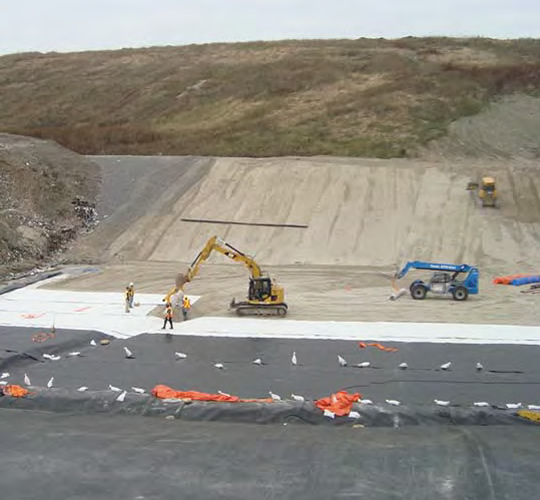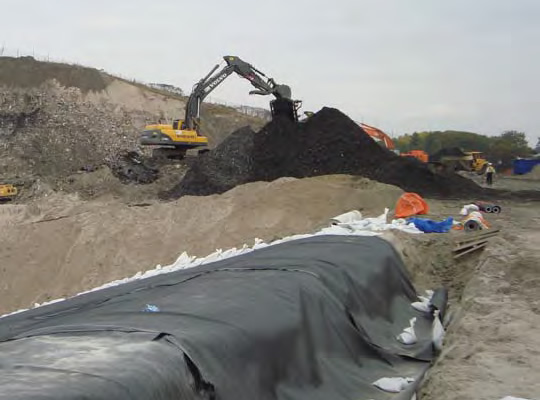
 When the City of Barrie (Ontario) landfill reached capacity, an extensive program was enacted to recycle material from the old cells. Non-recyclable material was then reburied with the additional protection of a multi-layered geosynthetic barrier system. The system utilized an HDPE geomembrane – GCL barrier system.
When the City of Barrie (Ontario) landfill reached capacity, an extensive program was enacted to recycle material from the old cells. Non-recyclable material was then reburied with the additional protection of a multi-layered geosynthetic barrier system. The system utilized an HDPE geomembrane – GCL barrier system.
BETTER GCL BARRIER SYSTEMS
Terrafix installed the geosynthetic system, which included a 60-mil, textured high-density polyethylene (HDPE) geomembrane and a Bentofix® geosynthetic clay liner (GCL).
Considering the capacity limitations of the landfill, the use of a GCL instead of a significantly thicker, traditional compacted clay layer won the site owners valuable air space. It also provided greater shear strength, stability, and resistance to desiccation than a conventional soil layer, as well as offered quicker, higher quality installation.
Geosynthetic clay liners are composite materials that feature a layer of high-swelling bentonite sandwiched between geosynthetic cover and carrier layers (generally nonwoven geotextiles).
The product utilized in Barrie’s project, Bentofix®, was constructed with needlepunched nonwoven geotextiles to secure the powdered sodium bentonite core.
Bentonite is the highest swelling natural clay used in these civil engineering applications. As it swells, it creates an essentially impermeable barrier to liquids. The swelling capacity also means that if the system is punctured, the bentonite, held firmly in place by the robust geotextile cover and carrier layers, will swell around the puncturing element or swell to “self-heal” a hole that has been created. Thus, the system’s impermeability remains.
The security of the bentonite is vital to the integrity of landfill lining and capping systems and other environmental barrier applications. When a GCL is installed below a geomembrane, such as the HDPE geomembrane used in this project, the GCL hydrates as it takes up moisture from the underlying soil with only the leachate collection system in place and with the waste not placed until after hydration has occurred. The GCL can subsequently be vulnerable to pull out of the nonwoven fibers with the hydration occurring at low stress.
The needlepunching process in the manufacture of the GCL goes one step towards creating a pull out-resistance bond of the geotextile, which is essential to the bentonite layer’s stability.
This process, pioneered by NAUE GmbH & Co. KG in 1987, was even honored with an IGS Award, the highest honor given by the International Geosynthetics Society. That award, issued in 2008, recognized the beneficial impact on the field of needlepunching GCLs during manufacture.
To further enhance the shear stress and strength of the material, Bentofix® is produced with a Thermal Lock process that applies heat in manufacture along with the needlepunching. The process creates an even stronger bond for the nonwoven fibers. The combination of needlepunching and thermal treatment reduces the amount of swelling in the system, creating a more favorable bulk void ratio for lower permeability in the lining system. Hydraulic conductivity and diffusion coefficient characteristics are improved.
The heat burnishing makes the carrier geotextile far more resistant to pull out during hydration at low stress.
As such, the selection of not just a GCL but a Bentofix® GCL barrier was important to achieving an efficient and economical containment system while ensuring strong, safe, long-term performance.
GCL BARRIER RESEARCH
A great deal of research has been conducted on geosynthetic clay liners in the past 20 years. A number of important studies have been carried out by Queen’s University here in Canada (and which terrafix® is proud to have been a part of).
Research also shows that while needlepunching is highly effective for GCL pull out resistance, Thermal Lock GCLs provide a lower Bulk Void Ratio. Petrov et al. (1997), for example, showed that needlepunching has a significant effect on the bulk void ratio by comparing results for a needlepunched GCL barrier and an otherwise similar GCL without needlepunching. Lake and Rowe (2000) demonstrated that heat burnishing (Thermal Lock) of needlepunched fibres can signicificantly influence the bulk GCL void ratio.
Of the GCLs tested, heat-burnished needlepunched GCLs provided the best performance.

The table shown here presents results for tests wherein the stress is applied prior to hydration. It shows that the effect of thermal treatment is even more significant for cases in which the sample is allowed to hydrate at a low confining stress (e.g., 6 kPa) and when, after hydration, stress is applied.
For the City of Barrie, all of this research, manufacturing innovation and quality control, and on-site installation expertise and quality assurance have led to a highly effective landfill barrier system. Recylcing and geosynthetics have enabled the community to extend the lives of waste cells and establish exemplary approaches for future cell constructions.
Find more case studies, geosynthetic product and application information, and additional resources and contacts at www.terrafixgeo.com.












